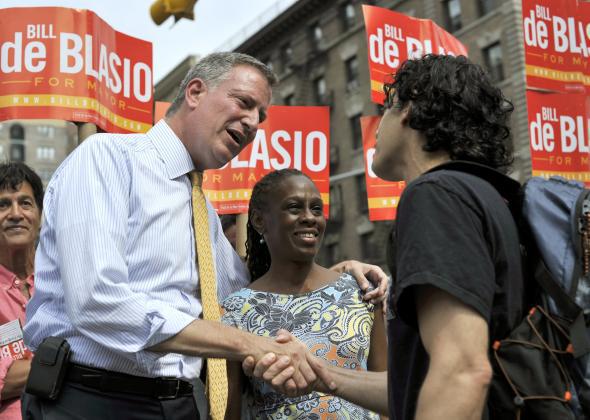This week, the New York Times published a profile of soon-to-be first lady of New York City Chirlane McCray. A largely positive piece, it touches on her sexuality and work with New York’s black feminist movement in the 1970s. But toward the end, the story of how McCray met her husband-to-be seems to hint at some juicy gossip:
By the time she started a job in the press office of New York’s City Hall in 1991, there was no confusion: she had zero interest in dating a man, a message that Mr. de Blasio, then a lanky, bearded operative across the building, jauntily ignored.
He flirted with her mercilessly, she said, calling nonstop and trying to steal an unwelcome kiss. “I actually told him, ‘Slow this down,’ ” Ms. McCray said. Her resistance became less diplomatic: “Back off.”
But a romance blossomed: Mr. de Blasio, five years her junior, won over her family with an overnight visit that earned him a new moniker: “Brother Bill.”
Out of the context, that sounds like grounds for a workplace harassment lawsuit. Scandalous! But the Times omitted a small detail from the story: The “back off” moment came after de Blasio and McCray had already started dating, and referred to de Blasio’s desire to progress their relationship. “He was more serious more quickly than I was, because I was coming from a very different place,” McCray told me, noting that she hadn’t dated a man or planned to in quite some time. “He was sweetly persistent, but he was always respectful.”
McCray was quick to dispel the notion of a workplace scandal, and said she regrets how she phrased the “back off” comment. “It was not put very elegantly, but it was not because he was in any way out of line,” she says. “As it’s written, it’s not the whole story.”
Here is the full story of how they met, as McCray told it to me: In 1991 she was working in the city’s Commission on Human Rights press office. Though the office was conservative, she wore a nose ring and African-style Batik dresses. One of her first days on the job, she was instructed to write a press release for Mayor David Dinkins endorsing candidates for city council races. A co-worker told her she should ask a man named Bill de Blasio for help, so she walked over to his cubicle to find a 6-foot-5 man hunched over his desk on the phone. He wasn’t helpful with her assignment, and McCray returned to her desk unimpressed. Afterward, de Blasio started hanging around the press office every day. He tried to get McCray’s attention by mentioning he’d bought the tie he was wearing in Togo, to which she responded, “I don’t know why you went all the way to Togo to get that tie.”
A week or two later, McCray was puzzled to pick up the phone and hear de Blasio’s voice on the line. After listening to him ramble for a few minutes, she finally blurted out, “What do you want?” After a tangible silence on the other end of the line, he slowly said, “I simply thought that we might have lunch one day.” Embarrassed, she took him up on his offer, and they went to lunch a few days later on an unseasonably cold September day. They started dating, but McCray was still hesitant to get serious, had a lot of things to work through in her head. She told him they needed to slow down. They did—for 22 years.
So there you have it: not as scandalous as the original article might have you believe. It’s the media’s job, after all, to pan muddy river beds for glinting nuggets of scandal. But the murk is usually much more interesting.
